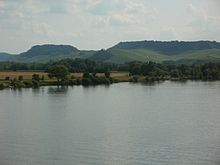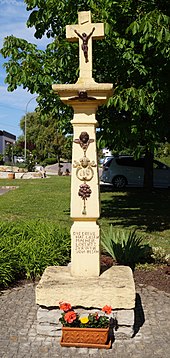Battle of Remich
| date | April 11, 882 |
|---|---|
| place | Remich , today's Luxembourg |
| output | Victory and voluntary retreat of the Vikings |
| Parties to the conflict | |
|---|---|
|
Vikings |
local contingent |
| Commander | |
|
Gottfried , Sigfrid |
|
| Troop strength | |
| unknown | unknown |
| losses | |
|
unknown |
unknown |
In the Battle of Remich on April 11, 882, a local contingent led by the Bishops of Metz and Trier and the Count of Metz fought against an army of Vikings on a raid .
history
In November 881 Viking armies overwintered under their leaders Gottfried and Sigfrid near Ascloha ( Elsloo on the Maas or Asselt in the Dutch province of Limburg ). From there they went on raids, including up the Rhine and Moselle . It is said to have been only a few hundred warriors. For their advance they used at least three longboats, on which there were also horses.
Coming from Koblenz , the Vikings attacked the churches and farmsteads located extra muros in Trier during Holy Week 882 . On Maundy Thursday , April 5, 882, they took the city themselves. After a few days of rest, the Vikings looted and ravaged Trier on Easter Sunday . Regino von Prüm reports of numerous victims among the population, but Archbishop Bertolf von Trier managed to escape to Metz with a few followers . Then some of the Vikings moved with the booty down the Moselle towards Koblenz, while the rest moved towards Metz.
In the floodplain of the Moselle between Remich , Nennig and Besch , in today's border area between Luxembourg and the Saarland , the Vikings faced a small local contingent on April 11, 882, led by Bishops Wala von Metz and Bertolf von Trier and von Graf Adalhard II of Metz . The Vikings won, Wala fell in battle, Adalhard and Bertolf were able to flee. During the fighting, the old Roman villa of Nennig was finally destroyed.
Despite the victory, the Vikings did not advance further on Metz, but returned to their camp in Ascloha via Bingen and Mainz . In addition to the resistance they encountered, one reason for the withdrawal was the return of Charles III, who was crowned emperor in Rome in February 881 . who gathered a strong army after the Diet of Worms in May 882 and besieged the Ascloha camp in July of the same year .
The Battle of Remich marks the southernmost point of the advance of the Vikings in the Rhineland and thus proves to be a successful resistance despite the military defeat of the local contingent.
Ten years later, in February 892 , another Viking army moved along the Moselle via Trier, which was looted again, towards Koblenz and then down the Rhine towards Bonn . At Lannesdorf a contingent of the local population was opposed. The Vikings avoided this fight and moved to the Eifel, where they burned the Prüm Abbey as they did ten years before and killed or abducted numerous people.
Commemoration
According to a local legend , Bishop Wala is said to have been buried in the “Mahlknopf”, a burial mound not far from the Roman villa of Nennig. However, the burial mound dates from the Roman Empire and Wala was buried in a mausoleum in the St. Salvator Church of Metz.
In 1688 , a stone cross called the "Norman Cross" or "Bishop Walo Cross" was erected near Besch at the place where, according to legend, Bishop Wala was killed. The inscription on the cross reads: DIS CREVE HAT LASEИ MACHEИ LOREИTZ SVRWIИ VOИ Besch 1688 LSW . In 1973 the cross had to give way to a newly laid road and was erected at its current location. The cross itself does not reveal any reference to battle; it is more like other stone crosses that were erected in the 17th century in Besch and the surrounding area and that are interpreted as plague crosses (see list of architectural monuments in Perl ).
In Besch there are also a “Normannenstrasse” and a “Bischof-Walo-Strasse” commemorating the battle.
Remarks
- ↑ RI I n.1627a in: Regesta Imperii Online (accessed July 27, 2013).
- ^ Regino von Prüm , Chronik , ad a. 882
- ^ Regino von Prüm, Chronik , ad a. 892.
- ^ Alfons Kolling : The tumulus "Malknopf" . In: Jan Lichardus , Andrei Miron (ed.): The Merzig Wadern district and the Moselle between Nennig and Metz (= guide to archaeological monuments in Germany 24) . Theiss, Stuttgart 1992, pp. 147-151.
- ↑ Information on the Besch district on the website of the municipality of Perl , accessed on February 25, 2014.
- ^ Waldemar Bach: Parish Perl in old views . European Library, Zaltbommel, Netherlands 1984, no.31.
literature
- Walther Vogel : The Normans and the Franconian Empire up to the founding of Normandy (= Heidelberg Treatises on Middle and Modern History. Volume 14). Winter, Heidelberg 1906, pp. 282-294.
- Eugen Ewig : The Trier region in the Merovingian and Carolingian empires. In: History of the Trier Land (= series of publications on Trier regional history and folklore. Volume 10). Working group for regional history and folklore of the Trier area, Trier 1964, pp. 222–302, here pp. 284–286.
- Burkhard Apsner: The high and late Carolingian times (9th and early 10th centuries). In: Heinz Heinen , Hans Hubert Anton , Winfried Weber (eds.): History of the Diocese of Trier. Volume 1. In the upheaval of cultures. Late antiquity and the Middle Ages (= publications of the Trier diocese archives. Volume 38). Paulinus, Trier 2003, pp. 255-284, here pp. 273-274.
Web links
- Jennifer Striewski: Vikings on the Middle Rhine. Rhenish History Portal, February 25, 2013, accessed on July 28, 2013 .


